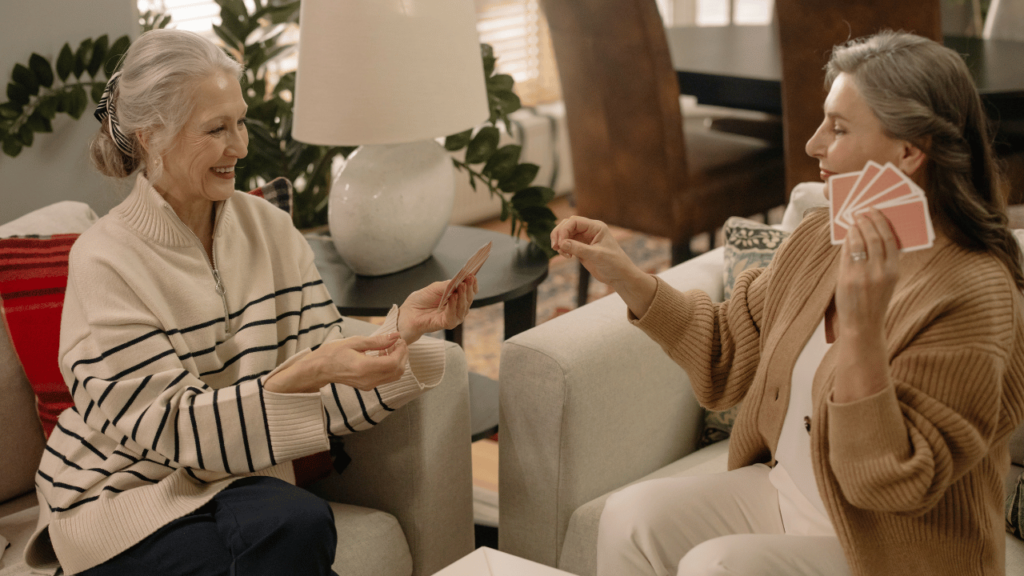How to Host a Game Night: Fun and Connection for All Ages

Game nights are more than just a way to pass the time—they’re an opportunity to connect, laugh, and make lasting memories with family and friends. Whether you’re gathering with grandchildren, neighbors, or old friends, hosting a game night is a simple and delightful way to bring people together. Good health lets you enjoy the moments that matter most. Visit SeniorHMOplans.com to explore health plans tailored for your vibrant lifestyle. Step-by-Step Guide to Hosting the Perfect Game Night Choose the Right Games: Select games that suit your group’s preferences and age range. Some popular choices include: Classic Board Games: Monopoly, Scrabble, or Clue. Card Games: Uno, Rummy, or Hearts. Interactive Games: Pictionary, Charades, or trivia. Keep a mix of quick, lighthearted games and longer, strategic ones to cater to everyone. Set Up a Comfortable Space: Arrange seating that’s cozy and promotes interaction. Use a large table for board games or create a lounge area for more relaxed games. Ensure good lighting and easy access to snacks and drinks. Pick a Theme (Optional): Add excitement with a theme like “Retro Games Night” or “Casino Night.” Coordinate decorations, music, and snacks to match the theme. Prepare Snacks and Refreshments: Offer finger foods like popcorn, veggie trays, or sliders that are easy to eat during gameplay. Include a mix of savory and sweet options, as well as drinks like lemonade, coffee, or mocktails. Include Virtual Participants: Use video conferencing platforms to involve family or friends who can’t attend in person. Choose games that work well online, like trivia or virtual Pictionary. Practical Tips for Success Know Your Audience: Choose games that align with your group’s interests and skill levels. Start Small: Limit the number of games for your first game night to keep things simple and manageable. Have a Backup Plan: Keep extra games or activities on hand in case your group wants a change of pace. End on a High Note: Wrap up the evening with a fun group photo or a final round of a favorite game. Common Questions Answered What are some classic games everyone will enjoy? Monopoly, Scrabble, and Uno are timeless favorites. Charades and trivia games are also great for large groups. How can I include family members who don’t live nearby? Use apps or video calls to connect virtually. Platforms like Zoom and Skype work well for playing games remotely. What if some guests aren’t familiar with the games? Choose simple, easy-to-learn games and provide a quick explanation or demonstration before starting. Why Game Nights Are Perfect for Seniors Game nights offer more than entertainment—they foster connection, laughter, and a sense of community. For seniors, hosting a game night is a wonderful way to stay engaged, strengthen relationships, and create joyful memories with loved ones of all ages. Imagine the sound of laughter as your family competes in a lively round of Pictionary or the warm feeling of sharing a snack between games. Picture your grandchildren asking, “When’s the next game night?” Hosting a game night isn’t just an event—it’s a tradition in the making. Plan your perfect game night today! For more inspiration, visit SeniorSearching.com.
How to Plan a Memorable Family Reunion After 60

Family is everything, and a reunion is a perfect way to bring everyone together. Whether it’s been years or just months since your last gathering, planning a reunion creates lasting memories for generations to cherish. It’s an opportunity to reconnect, celebrate, and strengthen the bonds that matter most. Good health lets you enjoy every moment with your loved ones. Visit SeniorHMOplans.com to explore health plans tailored for your vibrant lifestyle. Step-by-Step Guide to Planning Your Family Reunion Choose the Perfect Date: Pick a date that works for most family members. Weekends or holidays often work best, giving everyone time to travel and participate. Use an online poll or group chat to find a date that suits everyone. Select a Location: Host the reunion at a meaningful location, such as a family home, park, or rented venue. Consider accessibility for all ages and ensure there are comfortable spaces for seniors and young children. Set a Budget: Determine how much you can spend and decide whether costs will be shared among attendees. Include expenses like food, decorations, activities, and accommodations. Plan Activities for All Ages: Organize games, crafts, and outdoor activities for kids. Include storytelling sessions or slideshow presentations to share family history and memories. Schedule time for group photos, ensuring everyone is included. Create a Menu: Plan a potluck where everyone contributes a dish, or hire a catering service for convenience. Incorporate family recipes to add a nostalgic touch to the meal. Send Invitations: Use digital tools like Evite or WhatsApp to send invitations, or opt for printed cards for a more personal touch. Include all the details: date, location, activities, and RSVP instructions. Practical Tips for a Smooth Reunion Delegate Tasks: Assign roles to family members, such as organizing activities, managing RSVPs, or coordinating food. Capture the Memories: Hire a photographer or assign someone to take photos throughout the event. Consider setting up a photo booth with props for added fun. Prepare a Backup Plan: If hosting outdoors, have an indoor option in case of bad weather. Provide Keepsakes: Create small mementos like custom T-shirts, photo albums, or keychains to commemorate the reunion. Common Questions Answered How do I involve family members in the planning? Create a planning committee or divide tasks among volunteers. Involving others lightens the workload and ensures everyone feels included. What are creative ways to share family history? Organize a “family tree” activity where everyone contributes names and photos. Share stories from older generations during a dedicated session. How can I make the reunion enjoyable for everyone? Plan a mix of activities that cater to different interests and ages. Provide quiet areas for relaxation alongside lively group games. Why Family Reunions Are Perfect for Seniors A family reunion is more than just a gathering—it’s an opportunity to celebrate your legacy and create cherished memories. For seniors, it’s a chance to reconnect with loved ones, share stories, and see the next generation grow. Planning a reunion also strengthens family bonds, ensuring that traditions and values are passed down. Imagine the joy of watching your grandchildren play together, the laughter of shared memories, and the warmth of being surrounded by the people you love most. A family reunion brings generations closer, reminding everyone of the importance of family. Start planning your unforgettable family reunion today! For more tips and inspiration, visit SeniorSearching.com.
How to Start a Walking Group: Stay Active and Build Community

Walking is one of the easiest and most effective ways to stay active, boost your mood, and improve your health. But walking doesn’t have to be a solo activity. Starting a walking group adds the joy of community, making exercise more fun and fulfilling. Whether it’s with friends, neighbors, or new acquaintances, a walking group can turn simple strolls into shared adventures. Good health supports every step of your journey. Visit SeniorHMOplans.com to explore health plans tailored for your vibrant lifestyle. Step-by-Step Guide to Starting Your Walking Group Recruit Members: Start by inviting friends, family, or neighbors who share your interest in staying active. Use community boards, social media, or local organizations to spread the word. Set a Schedule: Choose days and times that work for most members. Early mornings or evenings often work well for cooler weather. Decide how often the group will meet—daily, weekly, or a few times a month. Plan Your Routes: Pick safe, scenic routes like parks, trails, or quiet neighborhoods. Consider accessibility and provide options for different fitness levels. Ensure Safety: Encourage members to wear comfortable shoes and reflective clothing if walking in low-light conditions. Carry water, a phone, and basic first aid supplies for emergencies. Add Variety: Plan themed walks, like nature walks or historical tours, to keep things interesting. Incorporate challenges, such as step goals or scavenger hunts, for added motivation. Practical Tips for Success Keep It Flexible: Allow members to join or leave as their schedules permit. Celebrate Milestones: Recognize members’ achievements, like completing a certain number of miles or reaching a fitness goal. Combine Socializing: Use the walks as an opportunity to catch up, share stories, or discuss hobbies. Invite Guest Speakers: Occasionally, invite a local fitness expert or naturalist to make the experience more engaging. Common Questions Answered What’s the best way to start a walking group? Begin by reaching out to people you know and choosing a convenient meeting spot. Promote your group through community channels to attract more participants. How do I ensure the group accommodates different fitness levels? Encourage members to walk at their own pace. Split into smaller groups if needed, or plan routes with optional shortcuts. Can I start a walking group with just a few people? Absolutely! A small group can be just as rewarding, and you can always grow your group over time. Why Walking Groups Are Perfect for Seniors Walking groups offer more than just physical benefits—they create opportunities for connection, laughter, and shared experiences. For seniors, they provide a way to stay active, combat loneliness, and build lasting friendships. Imagine strolling through a park with friends, sharing stories, and enjoying the fresh air. Picture the sense of accomplishment as your group reaches a fitness goal together. A walking group isn’t just about staying active—it’s about taking steps toward a healthier, happier life. Start your walking group today and take steps toward better health and community! For more inspiration, visit SeniorSearching.com.
The Art of Letter Writing: Reviving a Timeless Tradition

There’s something magical about receiving a handwritten letter. In today’s fast-paced digital world, taking the time to put pen to paper feels personal, thoughtful, and deeply meaningful. Letter writing is more than just communication—it’s an art form that connects hearts, revives memories, and captures moments that can be cherished forever. Good health lets you cherish moments that matter most. Visit SeniorHMOplans.com to explore health plans designed for your vibrant lifestyle. Step-by-Step Guide to Writing Thoughtful Letters Choose Your Tools: Select stationery that reflects your personality, such as elegant note cards, colorful paper, or vintage-style sheets. Invest in a smooth-writing pen or even experiment with calligraphy for an artistic touch. Set the Mood: Find a quiet, comfortable space where you can focus without distractions. Light a candle or play soft music to make the experience enjoyable and calming. Start with a Warm Greeting: Address the recipient by name and begin with a heartfelt salutation, such as “Dear [Name],” or “My Dearest [Name].” Share Your Thoughts: Write about your day, a recent experience, or a cherished memory. Include personal updates, kind words, and expressions of gratitude to make the letter meaningful. Add Personal Touches: Decorate your letter with small doodles, stickers, or pressed flowers. Include a photo, poem, or recipe to make the letter extra special. End on a High Note: Close with a heartfelt message, such as “Thinking of you always,” or “With all my love.” Sign your name in a way that feels personal and warm. Practical Tips for Embracing the Art of Letter Writing Reconnect With Old Friends: Reach out to loved ones you haven’t spoken to in a while. A letter is a beautiful way to bridge the distance and rekindle relationships. Find New Pen Pals: Join online groups or clubs that connect people interested in letter writing. Exchanging letters with new friends can be exciting and inspiring. Explore Unique Stamps: Visit your local post office or shop online for decorative stamps that make your letters stand out. Preserve Letters: Keep letters you receive in a special box or scrapbook to revisit them in the future. Common Questions Answered Why is letter writing still important in the digital age? Handwritten letters offer a personal touch that emails and texts can’t replicate. They show thoughtfulness and create lasting keepsakes. How can I make my letters more creative? Experiment with colors, embellishments, and themes. For instance, write a letter as if you’re telling a story or reflecting on a shared memory. What if I don’t know what to write? Start with a simple question, like “How have you been?” or share something about your day to get the conversation going. Why Letter Writing Is Perfect for Seniors Letter writing is a calming, reflective activity that allows you to connect with others while preserving your stories and thoughts. For seniors, it’s an opportunity to revisit cherished memories, express gratitude, and share wisdom with loved ones. Writing letters also provides a sense of purpose and joy as you create something truly meaningful. Imagine the smile on a friend’s face as they open a beautifully written letter from you. Picture the satisfaction of holding a completed letter, knowing it carries a piece of your heart to someone special. This timeless tradition enriches relationships and leaves a lasting legacy of love and connection. Rediscover the joy of letter writing today! For more inspiration, visit SeniorSearching.com.
How to Start a Daily Gratitude Practice for a Happier Life

Happiness often comes from appreciating the little things in life. A daily gratitude practice helps you focus on the positive, creating a sense of peace and joy. It’s a simple habit that can make a big difference, helping you start each day with a brighter outlook and end it with a sense of fulfillment. Good health lets you enjoy the moments that matter most. Visit SeniorHMOplans.com to explore health plans designed for your vibrant lifestyle. Step-by-Step Guide to Starting a Gratitude Practice Set Aside Time Each Day: Dedicate a few minutes in the morning or evening to reflect on things you’re thankful for. Choose a quiet spot where you won’t be interrupted. Start a Gratitude Journal: Write down three things you’re grateful for each day. These could be as simple as enjoying your morning coffee or as meaningful as a call from a loved one. Be specific—describe why you’re thankful and how it makes you feel. Share Your Gratitude: Tell friends or family members why you appreciate them. A quick note, text, or phone call can brighten their day and strengthen your connection. Practice Verbal Affirmations: Say out loud what you’re grateful for. For example, “I’m thankful for this beautiful weather today.” Verbalizing gratitude reinforces positive thinking. Incorporate Gratitude Into Daily Activities: While walking, cooking, or relaxing, think about the things you appreciate in your life. Pairing gratitude with routine activities makes it an effortless habit. Practical Tips for Success Keep It Simple: Focus on quality, not quantity. A few heartfelt moments of gratitude are more impactful than a long list. Use Prompts for Inspiration: If you’re unsure where to start, use prompts like: “What made me smile today?” “Who helped me recently, and how can I thank them?” “What is something I often take for granted?” Stay Consistent: Build your gratitude practice into your daily routine to make it a habit. Celebrate Progress: Reflect on how your gratitude practice has improved your mood or relationships over time. Common Questions Answered What are the benefits of a gratitude practice? Gratitude has been shown to reduce stress, improve relationships, and increase overall happiness. It also promotes better sleep and a healthier mindset. How do I stay consistent with my gratitude routine? Set reminders or pair your gratitude practice with another daily habit, like brushing your teeth or enjoying your morning coffee. Can I include gratitude for small things? Absolutely! Appreciating everyday moments, like a warm meal or a kind gesture, can bring just as much joy as major events. Why Gratitude Practices Are Perfect for Seniors A daily gratitude practice is a simple way to cultivate mindfulness and focus on life’s blessings. For seniors, it’s an opportunity to reflect on cherished memories, appreciate the present, and create a positive mindset for the future. Gratitude also fosters connections with others, enhancing relationships and creating a sense of community. Imagine starting your day by recalling a fond memory or expressing appreciation for a loved one. Picture the joy of sharing your gratitude with friends or family, deepening your bonds. This practice isn’t just about happiness—it’s about finding meaning and beauty in every moment. Discover the power of gratitude today! For more inspiration, visit SeniorSearching.com
How to Host a Virtual Book Club: Stay Connected and Share Stories

A great book can take you on an unforgettable journey, and sharing that experience with others makes it even more special. Hosting a virtual book club is a wonderful way to stay connected with friends and family, no matter where they are. It’s easy to set up, fun to participate in, and a fantastic way to build deeper relationships while exploring the joy of reading. Good health lets you enjoy the stories that matter most. Visit SeniorHMOplans.com to explore health plans designed for your vibrant lifestyle. Step-by-Step Guide to Hosting a Virtual Book Club Choose Your Platform: Pick a user-friendly video conferencing platform like Zoom, Skype, or Google Meet. Many of these services offer free versions for small groups. Test the platform ahead of time to ensure it works smoothly for everyone. Invite Your Members: Reach out to friends, family, or neighbors who enjoy reading. Use email, social media, or even handwritten invitations to get the word out. Aim for a group of 5–10 people to keep discussions lively but manageable. Select Your First Book: Start with a popular or highly recommended book to spark interest. Consider taking votes or creating a rotation where each member picks a book. Choose books that are widely available in multiple formats, including eBooks, audiobooks, and large print editions. Set a Schedule: Decide on a regular meeting time, such as once a month. Consistency makes it easier for everyone to plan ahead. Allow enough time for members to read the book without feeling rushed. Prepare Discussion Questions: Compile a list of open-ended questions to guide the conversation. For example: “Which character did you relate to the most and why?” “What surprised you about the story?” “How did the book’s setting influence the plot?” Practical Tips for a Successful Virtual Book Club Keep It Inclusive: Encourage everyone to share their thoughts but also respect those who prefer to listen. Add Some Fun: Host themed meetings where members dress as characters or enjoy snacks inspired by the book. Be Flexible: If someone can’t finish the book, let them join the discussion anyway—they may still enjoy hearing others’ perspectives. Record Highlights: Use the platform’s recording feature (with everyone’s permission) to capture memorable moments or insights. Common Questions Answered What’s the best way to choose books everyone will enjoy? Rotate the responsibility of selecting books among members, or create a list of suggestions and vote on the next read. How do I help less tech-savvy members join the meetings? Provide step-by-step instructions for using the platform. Offer to set up a trial run to help them feel comfortable. Can I include members who don’t live locally? Absolutely! A virtual book club allows you to connect with friends and family across the country—or even the world. Why Virtual Book Clubs Are Perfect for Seniors A virtual book club combines the joy of reading with the fulfillment of social interaction. For seniors, it’s an excellent way to stay mentally engaged, combat loneliness, and share meaningful conversations. Discussing books with others fosters connection and creates a sense of community, even from a distance. Picture this: you’re laughing over a funny scene, debating a character’s choices, or sharing how a story touched your heart—all while staying cozy in your favorite chair. Virtual book clubs bring people together in a way that feels personal, enriching, and enjoyable. Start your literary journey and build connections that last. For more inspiration, visit SeniorSearching.com.
How to Start a Neighborhood Walking Club for Seniors

Walking is one of the easiest and most enjoyable ways to stay active, and doing it with neighbors makes it even better! Starting a neighborhood walking club is a great way to improve your health, make new friends, and create a sense of community right in your own neighborhood. With just a little planning, you can take the first step toward a healthier and happier lifestyle. Good health starts with an active lifestyle. Visit SeniorHMOplans.com to explore health plans that help you keep moving and thriving. Step-by-Step Guide to Starting a Walking Club Plan Your Walking Routes: Choose safe, scenic paths in your neighborhood or nearby parks. Keep routes accessible for all fitness levels, with options for shorter and longer walks. Set a Schedule: Decide on regular meeting days and times, such as mornings or evenings when the weather is cooler. Start with a manageable frequency, like twice a week, and adjust based on interest. Invite Your Neighbors: Spread the word through flyers, neighborhood bulletin boards, and social media groups. Personally invite neighbors you think might be interested, especially those who enjoy light exercise and socializing. Make It Fun and Engaging: Plan themed walks, like bird-watching, historical landmarks, or holiday decorations. Organize small challenges, such as step-count goals or photo scavenger hunts along the route. Stay Safe: Encourage participants to wear comfortable shoes and bring water bottles. Use reflective gear or lights if walking during early morning or evening hours. Walk in groups to ensure safety and companionship. Practical Tips for a Successful Walking Club Track Your Progress: Use pedometers or smartphone apps to measure steps and distance. Mix It Up: Explore new routes occasionally to keep things interesting and discover hidden gems in your area. Celebrate Milestones: Host a small celebration for reaching group goals, like walking 100 miles collectively. Combine Walking with Socializing: After each walk, plan a coffee meet-up or a picnic in the park to build stronger connections. Common Questions Answered How long should our walks be? Start with walks lasting 20–30 minutes, and adjust based on the group’s comfort level and stamina. What safety precautions should we take? Stick to well-lit areas, avoid busy roads, and carry a phone in case of emergencies. Walking as a group provides added safety and support. What if some participants can’t keep up? Encourage everyone to go at their own pace, with designated points to regroup. Consider having two pace groups if necessary. Why This Hobby Will Resonate Starting a neighborhood walking club isn’t just about physical activity—it’s about fostering community, making new friends, and enjoying the simple pleasure of walking together. Many seniors find that group activities help them stay motivated and accountable while reducing feelings of isolation. Walking clubs also provide a platform to share stories, support one another, and celebrate achievements. Imagine strolling through your neighborhood, chatting with friends while enjoying the sights and sounds of nature. Picture the laughter shared during a themed walk or the satisfaction of reaching a milestone together. These moments turn exercise into an enjoyable, shared experience that benefits both body and mind. Start your journey to health and happiness today! For more tips and inspiration, visit SeniorSearching.com.
Stay Sharp: Create a Senior-Friendly Puzzle Library at Home

Puzzles aren’t just games—they’re a journey for your brain. They help boost memory, improve problem-solving skills, and bring hours of relaxation and fun. Imagine having your own personalized puzzle library at home, ready for any quiet afternoon or lively puzzle night with friends and family. At SeniorSearching.com, we specialize in ideas that make your golden years vibrant and fulfilling. This article is proudly sponsored by SeniorHMOplans.com, your trusted resource for finding Medicare Advantage plans tailored for seniors. Because hobbies like puzzles are best enjoyed with good health, visit SeniorHMOplans.com to stay vibrant and active. 1. Why Create a Puzzle Library? Keep Your Brain Active: Puzzles enhance cognitive function, boost memory, and keep your mind sharp. Enjoy Social Connections: Puzzle nights with friends or family are a fun way to bond and share stories. Reflect Your Interests: Curate puzzles with themes you love, from landscapes to vintage designs. 2. Steps to Build Your Puzzle Library Select Your Storage System: Keep your collection organized with stackable bins, shelves, or labeled puzzle racks. Look for storage solutions that fit your space and make puzzles easy to access. Curate a Variety of Puzzles: Jigsaw Puzzles: Start with 500- to 1,000-piece sets for moderate difficulty. Word Puzzles: Include crossword books, word searches, or anagrams. Brain Teasers: Add Sudoku, logic puzzles, and trivia challenges to keep things interesting. Source Affordable Puzzles: Look for bargains at thrift stores, garage sales, and online marketplaces like eBay. Swap puzzles with friends or attend local community exchange events. 3. Maintaining and Sharing Your Puzzle Collection Rotate Your Puzzles: Trade puzzles with others to keep your library fresh and exciting. Protect Your Puzzles: Use resealable bags to store loose pieces and prevent damage. Label each puzzle with its theme and difficulty level for easy selection. Add Personal Touches: Create a catalog with notes about each puzzle’s story, completion time, and difficulty rating. 4. Make Puzzle Solving a Lifestyle Puzzles don’t have to be a solitary activity. Host puzzle nights, join online communities, or organize puzzle swaps in your neighborhood. Combine puzzles with a cozy setting, like tea or snacks, to turn it into an enjoyable routine. Conclusion Creating a senior-friendly puzzle library at home is a simple yet fulfilling way to stay sharp, have fun, and build social connections. At SeniorSearching.com, we bring you ideas to enrich your retirement years. Remember, hobbies like this are best enjoyed with good health. Visit SeniorHMOplans.com today to find a plan that keeps you thriving. FAQs Section 1. What types of puzzles are best for seniors? Jigsaw puzzles with 500 to 1,000 pieces are ideal for moderate difficulty. Word searches, crosswords, and logic puzzles are also excellent for variety and mental stimulation. 2. How can I organize a puzzle library in a small space? Use stackable bins or collapsible shelves to maximize vertical space. Label each puzzle box or bag for easy identification, and consider under-the-bed storage for larger collections. 3. Where can I find affordable puzzles? Check thrift stores, garage sales, or online marketplaces like eBay and Etsy. Many libraries or senior centers also host puzzle exchanges where you can swap puzzles for free. 4. What’s the best way to preserve old puzzles? Store puzzles in resealable bags to keep pieces secure and organized. For long-term preservation, keep them in a cool, dry place away from direct sunlight and humidity.
How to Start a Pen Pal Friendship After Retirement

Imagine the joy of receiving a handwritten letter in the mail—filled with stories, kindness, and connection. Starting a pen pal friendship after retirement is a wonderful way to meet new people, relive the charm of letter-writing, and brighten your days. It’s a low-cost, meaningful hobby that keeps your mind active and your heart full. And just like staying connected enriches life, good health ensures you have the energy to enjoy these experiences. That’s why SeniorHMOplans.com is here to support your well-being every step of the way. Why Pen Pals are Perfect for Seniors Builds Connections: Meet new people, share stories, and create lifelong friendships. Nostalgic and Fun: Revive the lost art of letter-writing and relive treasured memories. Boosts Mental Health: Writing and reading letters reduces stress and promotes happiness. Accessible and Affordable: All you need is a pen, paper, and a stamp. Step-by-Step Guide to Starting a Pen Pal Friendship Step 1: Find a Pen Pal Program Join senior-focused pen pal networks like PenPal World or Global PenFriends. Participate in local community or church initiatives connecting pen pals. Step 2: Write Your First Letter Introduce yourself with a friendly tone. Share your hobbies, interests, and a fun fact about yourself. Ask open-ended questions like, “What’s your favorite childhood memory?” or “Do you have a favorite hobby?” Step 3: Make It Personal Add a small touch to your letter, such as a photo, a pressed flower, or a drawing. Share a favorite recipe or a meaningful quote to inspire conversation. Step 4: Maintain the Friendship Respond promptly to letters to keep the connection alive. Be open and kind while respecting boundaries—everyone shares at their own pace. Step 5: Explore Digital Options If writing by hand is difficult, consider email or apps that facilitate pen pal exchanges for convenience. Tips for Success Use colorful stationery or cards to make your letters extra special. Keep your tone positive and warm to foster a friendly connection. Stay consistent—set aside time each week to write and read letters. FAQs 1. Are there pen pal programs for seniors? Yes! Many organizations connect seniors with pen pals of similar interests or different cultures. 2. How often should I write? A good pace is once or twice a month, but it depends on what works for you and your pen pal. 3. Can I use email instead of handwritten letters? Absolutely! Digital pen pals are a great alternative if handwriting is difficult. Personal Story: Susan’s Pen Pal Journey At 64, Susan joined a pen pal program to feel more connected after retiring. She was paired with a pen pal in Canada who shared her love of gardening. “We’ve been exchanging letters for over a year now,” Susan says. “It’s amazing how close we’ve become, even from so far away.” With the support of SeniorHMOplans.com, Susan stays healthy and energized to enjoy her weekly writing sessions. Why Your Health Matters for Staying Connected Engaging in activities like pen pal friendships is fulfilling and enriching, but staying healthy ensures you can enjoy these experiences to the fullest. That’s why SeniorHMOplans.com helps seniors find health plans that fit their needs, so they can focus on meaningful connections. Visit SeniorSearching.com for more inspiring ideas. Call-to-Action Ready to start your pen pal journey? Visit SeniorSearching.com for more creative hobbies and step-by-step guides designed for seniors.
Relax and Create: The Basics of Learning Calligraphy for Seniors

Calligraphy isn’t just beautiful handwriting—it’s an art form that offers relaxation, creativity, and a sense of accomplishment. Whether you’re creating heartfelt cards for loved ones or simply enjoying the process of learning something new, calligraphy is a fulfilling hobby for seniors. Sponsored by SeniorHMOplans.com, this guide will take you through the basics of calligraphy and provide actionable steps to help you get started. For more creative ideas tailored to seniors, visit SeniorSearching.com! Why Calligraphy? Calligraphy is more than a skill—it’s a therapeutic activity. Here are some key benefits: Relaxation: The repetitive motion of creating strokes has a meditative quality, reducing stress and promoting mindfulness. Improved Coordination: Practicing calligraphy strengthens hand-eye coordination and fine motor skills. Creative Expression: Calligraphy allows you to bring your unique style to projects like cards, wall art, or journals. Connection: Share your creations with friends and family or use your skills to design meaningful gifts. Step 1: Gather Your Supplies Starting calligraphy doesn’t require expensive tools. Here’s what you’ll need: Brush Pens: These are beginner-friendly and versatile for modern calligraphy styles. Practice Paper: Use smooth, high-quality paper to prevent ink from bleeding. Printer paper or calligraphy-specific pads work well. Templates or Guidelines: Download free printable guides to help with consistency. Ink and Dip Pen (Optional): If you’d like to try traditional calligraphy, invest in a dip pen and bottle of ink. Pro Tip: Look for starter kits online that bundle tools together to save time and money. Step 2: Learn the Basic Strokes Calligraphy is built on a foundation of simple strokes. Practice these basics: Upstrokes: Create thin, delicate lines by applying light pressure as you move your pen upward. Downstrokes: Press slightly harder to form thick, bold lines as you move downward. Transitions: Combine upstrokes and downstrokes to form curves and loops. Dedicate time to practicing each stroke until they feel natural. This repetition builds the muscle memory needed for consistent lettering. Step 3: Practice Simple Alphabets Begin with lowercase letters before moving on to uppercase. Here’s how to approach it: Trace Templates: Start by tracing letters to understand their structure. Focus on Spacing: Keep letters evenly spaced for a polished look. Experiment with Styles: Try modern calligraphy for a playful look or traditional scripts for classic elegance. Pro Tip: Practice one letter or word each day to gradually build confidence. Step 4: Create Your First Projects Once you’re comfortable with the basics, it’s time to put your skills to use. Here are a few beginner-friendly projects: Personalized Cards: Write a short quote or someone’s name to add a personal touch to greeting cards. Journals: Create headers or decorative elements for your personal journal. Home Decor: Frame a simple calligraphy piece to brighten your living space. Gift Tags: Add elegance to gifts with handwritten tags. Step 5: Stay Inspired and Keep Learning Calligraphy is a skill that grows with practice. To stay motivated: Join a Community: Look for local or online calligraphy groups to share tips and get feedback. Take Classes: Attend workshops or watch free tutorials on platforms like YouTube. Experiment with Colors and Styles: Try metallic pens or watercolor calligraphy to add flair. Document Progress: Keep your early works and revisit them to see how far you’ve come. Step 6: Enjoy the Journey Calligraphy is about enjoying the process as much as the results. Dedicate 15–30 minutes a day to practice, and don’t stress about perfection. Every stroke you make is a step toward mastering this beautiful art form. Conclusion: Learning calligraphy is a relaxing and rewarding hobby that opens the door to endless creative possibilities. Whether you’re writing a heartfelt note, creating decor, or simply practicing for fun, the joy of calligraphy lies in every stroke. Ready to start your journey? Visit SeniorSearching.com for more creative and inspiring ideas. And remember, SeniorHMOplans.com is here to support your health and happiness every step of the way!

